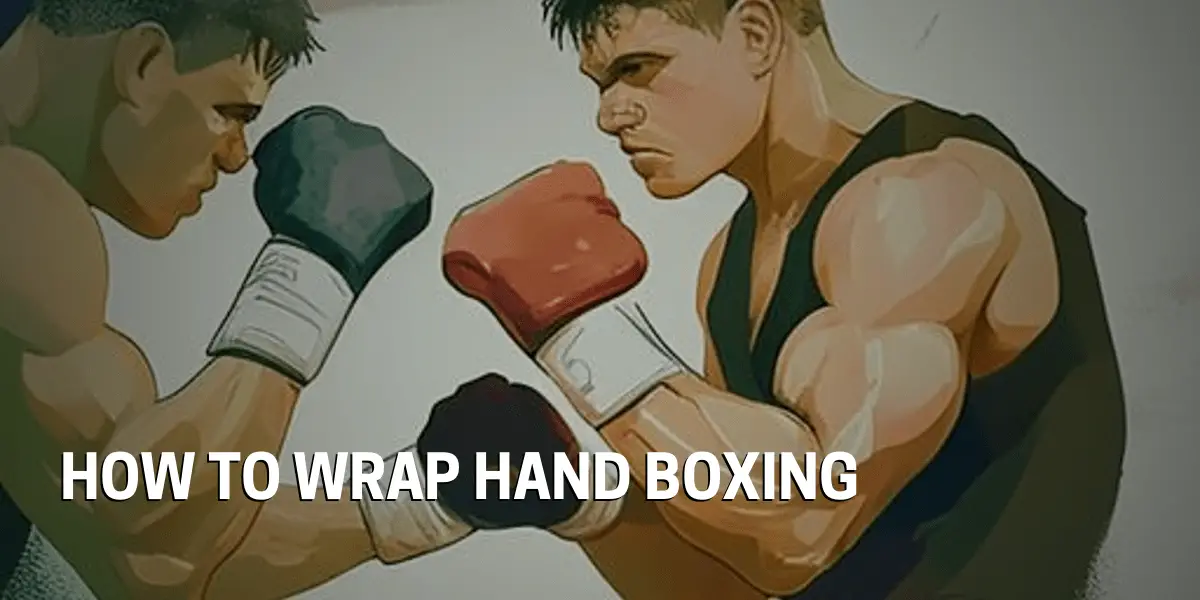Wrapping Hands for Boxing
Wrapping hands is the process of securing the hands with wraps or bandages before a fight, to protect the bones, ligaments and tendons of the fighter’s hands. Professional boxers, as well as amateur boxers, need to ensure their hands are well wrapped in order to avoid any potential injuries. Preparing your hands before wrapping is essential for achieving a secure and comfortable fit. Start by cleaning the hands with a clean towel, removing any debris or sweat.
Once the hands are clean and dry, apply the wraps around the wrists and then the knuckles, then wrap the hands in a circular motion up to the base of the fingers. Ensure the wraps are secure but not too tight. Wrapping the hands should be done with care, as too much tightness could limit the fighter’s hand movements.
When the wrapping is complete, secure the wraps with tape to ensure they stay in place. Make sure to leave a little bit of slack in the wraps so the fighter can make a fist without the wraps feeling too tight.
Finally, the fighter should check the wraps for any loose areas and adjust accordingly. Wrapping hands for boxing is an important step in the process of training and competing. It helps to protect the fighter’s hands and wrists, ensuring the fighter can perform at their best. It also helps to improve the fighter’s grip and helps to give the fighter a competitive edge.

Benefits of Wrapping Hands
Wrapping hands for boxing is an important step for any fighter, whether amateur or professional. We can see the benefits of it in the improved support for the wrist, knuckles, and fingers, as well as protection from bruising and reduced risk of injury.
It can also provide extra comfort when punching, reducing the pain and fatigue that can come from it.
How then can we safely and effectively wrap our hands?
Materials Needed
This article will focus on the materials needed to properly wrap your hands for boxing. In order to protect your knuckles and wrists, and reduce the risk of injury and bruising, the right materials are essential.
Gauze is an absorbent material that helps cushion the hands and absorb sweat. Athletic tape is then used to secure the gauze in place, providing extra support.
Scissors are necessary to cut the gauze and tape to the desired length and shape.
Steps to Wrap Hands
Wrapping your hands properly before boxing is essential to protect your knuckles and wrists and reduce the risk of injury and bruising. A proper wrap requires the right materials, such as gauze, athletic tape, and scissors.
To begin, lay the wrap flat on a firm surface and make sure it is long enough to cover your entire hand and wrist. Then, start by wrapping the wrap around the wrist, and move up the forearm for extra support.
Finally, secure the wrap with an overlapping motion in the middle of the palm and around the thumb.
Pre-Wrap
The importance of wrapping your hands before boxing cannot be overstated. Proper hand wrapping is essential for keeping the knuckles and wrists protected, and reducing the risk of injury and bruising.
Pre-wrap, also known as elastic bandage, is an important step in the hand-wrapping process. It is applied around the wrist, thumb, and back of the hand to provide an extra layer of protection and cushioning against friction and moisture. Wrapping should be done tightly but not too tightly to ensure that the hands stay secure and protected.
With the pre-wrap securely in place, it is time to move on to wrapping the knuckles. This requires taking a length of cloth, such as a cotton bandage, and wrapping it around the knuckles in a figure-eight pattern. Make sure to wrap the knuckles tightly so that they are secure and well-protected.

Wrapping the Knuckles
Wrapping the hands correctly before boxing is essential for protecting the knuckles and wrists from injury and bruising. We can start this process by placing the boxing wrap at the base of the thumb and wrapping it around each knuckle. It is important to ensure that the wrap is pulled tight and secure to prevent it from slipping.
Additionally, an extra layer of padding should be added over the knuckles to further protect them. When it comes to securing the wrist, the wrap should be wrapped around it and firmly secured.
Wrapping the Wrist
Wrapping the wrists before a boxing match is a crucial step to ensure optimal protection and comfort. How to do it properly may not be immediately apparent, but it’s a skill that every boxer or fight enthusiast should strive to master.
Ensuring the right fit is the first step – the wrap should be snug but not too tight. Applying the right amount of pressure for support is also key, as too much pressure can cause discomfort.
To achieve maximum comfort, it’s important to use specific techniques for wrapping the wrist, such as using a figure-eight motion.
Finally, the wrap should be secured with a knot or tape in order to keep it in place.
Wrapping the Thumb
Wrapping the thumb is an essential part of the process. To do it properly, start by wrapping the thumb in a figure-eight motion. Make sure the thumb is securely wrapped by crossing the wrap over the thumb joint.
Provide extra protection by wrapping the thumb twice and secure the wrap with a single tuck under the thumb. This will help to ensure the wrap does not come undone during the fight.
To finish up, some finishing touches are needed.
v. Finishing Touches
Wrapping hands for boxing is an art form that requires practice and expertise. To ensure a successful boxing wrap, the finishing touches are essential. We suggest starting by making sure the thumb is securely wrapped and lies flat against the hand.
Then, the wraps should be snug, but not too tight, to avoid discomfort and constriction. To provide further support and stability, tie the wraps at the wrist.
Finally, an optional roll of athletic tape can be used to provide additional support and protection.

Examples of Wrapping Techniques
Wrapping hands for boxing is an art form that requires practice and expertise. Knowing the various wrapping techniques is essential for an effective boxing wrap.
For starters, there are three main techniques for wrapping hands for boxing: the traditional wrap, the Velcro wrap, and the figure-eight wrap. The traditional wrap involves wrapping the hands in a figure-eight pattern and then securing them with boxing tape.
The Velcro wrap requires the use of a Velcro wrap, which wraps around the wrist and attaches to the boxing glove.
The figure-eight wrap involves wrapping the hands in a figure-eight pattern, starting from the wrist and working up to the knuckles.
Tips for Wrapping Hands
Wrapping hands for boxing is an important skill for boxers of all levels. For those who are just getting started, choosing the right boxing tape is essential for a secure and comfortable wrap.
It’s important to start by wrapping the wrist and hand with a layer of tape, making sure the tape is snug but not too tight.
After the first layer is in place, the knuckles should be secured with a second layer of tape that wraps around them. This will ensure the wrap is secure and will remain in place during the match.
For those who are more experienced, the figure-eight wrap is a more secure option, although it can take more time to complete.
Practicing proper wrapping techniques is essential to ensure a safe and successful boxing experience.
FAQs
What are the benefits of wrapping my hands for boxing?
The art of wrapping your hands for boxing is one of the most important skills a boxer can possess. Wrapping your hands offers a variety of benefits, such as reducing the risk of injury to your hands, wrists, and knuckles.
Providing support and stability, and protecting against cuts and abrasions, proper wrapping techniques can also help to ensure a safe and successful boxing experience.
But what are the materials you need to get the job done? Why is it so important to wrap your hands correctly?
What materials do I need to wrap my hands?
Wrapping your hands for boxing is an essential skill for any boxer. Not only does proper hand wrapping reduce the risk of injury, but it also provides the necessary support and stability for a successful boxing session.
But why is it so important to have the right materials for wrapping your hands? To get the job done, you need hand wraps, boxing gloves, and tape. Hand wraps, preferably cotton or gauze wraps, are the most important item for wrapping your hands. These wraps provide a secure and comfortable fit, as well as extra padding to protect your hands from cuts and abrasions.
Boxing gloves protect your hands from further damage and can also be used for extra padding in the wrap. Finally, tape is necessary for secure wrapping and extra padding. We must now learn the steps for wrapping our hands correctly.
What are the steps for wrapping my hands?
Wrapping your hands correctly is necessary to reduce the risk of injury, as well as to provide the necessary support and stability for a successful boxing session. When it comes to wrapping your hands, you need to have the right material for the job. Hand wraps, which are typically made of cotton or gauze, are essential for this task. They provide a secure and comfortable fit, as well as extra padding to protect your hands from cuts and abrasions.
Boxing gloves provide further protection, and can also be used to add extra padding to the wrap. Finally, tape is necessary to secure the wrap and provide further cushioning.
So, what are the steps for wrapping your hands correctly? To begin, start with a clean pair of hand wraps and wrap them tightly around your wrist and knuckles. Secure the wraps in place with a single loop around the thumb and an X-shape over the back of the hand. Make sure to leave some slack and adjust the wraps as needed for comfort before taping them in place.
Are there any examples of wrapping techniques?
Wrapping your hands correctly is necessary to reduce the risk of injury, as well as to provide the necessary support and stability for a successful boxing session. It’s important to use the right materials for the job; hand wraps, which are typically made of cotton or gauze, are essential for this task. They provide a secure and comfortable fit, as well as extra padding to protect your hands from cuts and abrasions. Boxing gloves provide further protection, and can also be used to add extra padding to the wrap. Finally, tape is necessary to secure the wrap and provide further cushioning.
But with all of the different wrapping techniques available, which one should you choose? The Mexican wrap involves wrapping a cloth or gauze around the wrist and knuckles several times and then looping the cloth over the thumb. The American wrap involves wrapping the wrist and knuckles with a cloth or gauze and then taping the thumb. The Thai wrap technique involves wrapping the wrist and knuckles with a cloth or gauze and then taping the thumb and looping the cloth over the knuckles. The figure 8 wrap technique involves wrapping a cloth or gauze around the wrist and knuckles several times and then looping the cloth around the thumb and knuckles in a figure 8 pattern.
v. What tips do you have for wrapping hands?
Wrapping your hands for boxing is an important skill to have, and one that must not be taken lightly. This is because proper wrapping of the hands is necessary to reduce the risk of injury, as well as to provide the necessary support and stability for a successful boxing session.
Start by making sure you have enough hand wraps and padding for each hand, and then wrap the hand wrap around each finger, securely but not too tight. It is also important to ensure the knuckles are correctly wrapped in order to ensure proper protection.
Be sure to use the right materials for the job; hand wraps, which are typically made of cotton or gauze, are essential for the task. They provide a secure and comfortable fit, as well as extra padding to protect the hands from cuts and abrasions.
Boxing gloves offer further protection, and can be used to add extra padding to the wrap. Finally, tape is necessary to secure the wrap and provide further cushioning.

